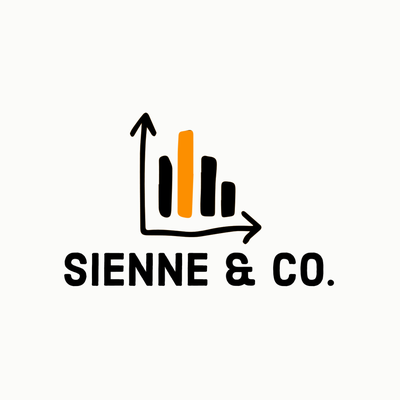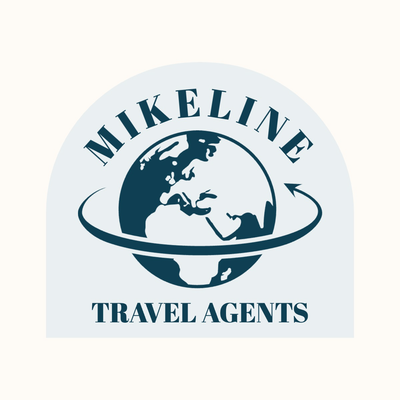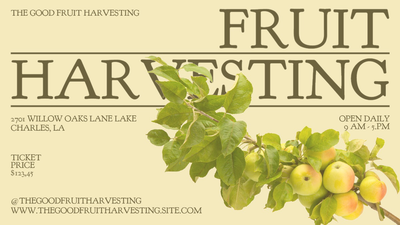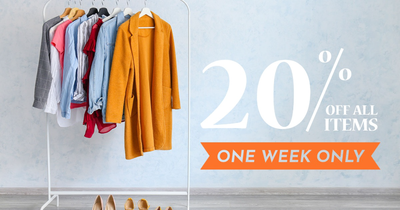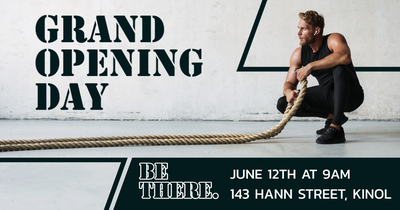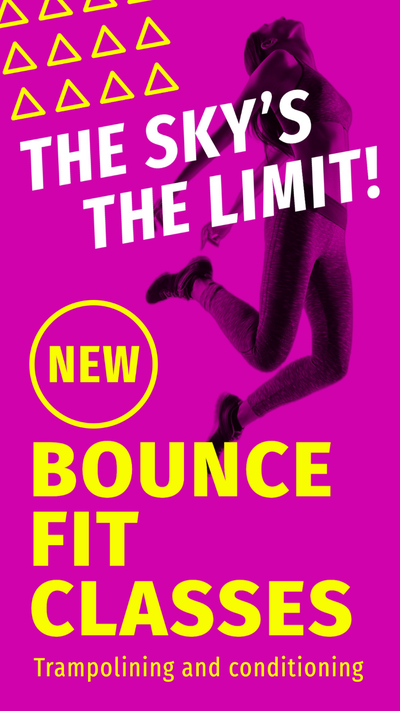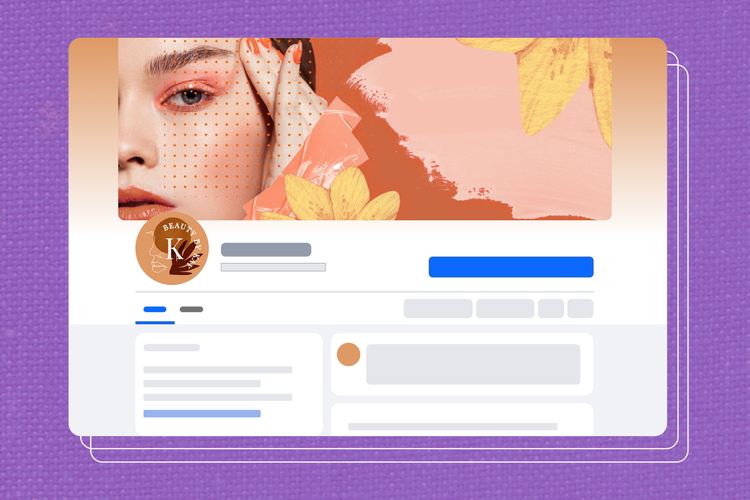How to create a Facebook Business Page and grow your brand
Learn how to make a Facebook Business Page in 6 simple steps with this comprehensive guide to optimizing your business on Facebook.

If there’s a king of the social media jungle, it’s Facebook. Ruling over the remaining social networks with over 2.9 billion users — before even adding in the company’s Instagram user base — the platform is a clear leader in the digital sphere. Learning how to harness that authority can be an asset for your work; when you align your brand with the king by building a Facebook business page, you can take the lead in your industry, too.
Before we dive into the step-by-step guide on how to start a Facebook Business Page, we will explain what exactly a Facebook Business Page is and its many benefits. Additionally, we’ll provide some tips and tricks on optimizing your business’ content and creating an engaged following on Facebook. Without further ado, let’s dive into this complete guide on how to create a Facebook business page that puts the spotlight on your brand — and keeps it there.
Key takeaways
- Your Facebook Business Page is your digital storefront. It’s where you connect with customers, build trust, and put your brand’s personality on full display — all in one place.
- Setting up is easy — and strategic. With just six simple steps, from naming your page to choosing eye-catching visuals and customizing your URL, you can make a strong first impression that aligns with your brand.
- It’s not just about posting — it’s about building. A strong Facebook marketing strategy helps you grow an engaged audience, share meaningful content, and turn followers into loyal fans.
- Take advantage of all the tools. From Facebook Ads and Stories to Messenger and pinned posts, Facebook gives you multiple ways to promote, connect, and stay top-of-mind.
- Track your impact with Insights. Use built-in analytics to learn what’s working, understand your audience better, and continuously fine-tune your strategy.
Summary/Overview
What is a Facebook Business Page?
A Facebook Business Page is a public social media profile for your business. Businesses can interact with their audience, promote products and services, and post status updates, photos, videos, and more. A Facebook Business Page is an excellent place for potential customers to learn more about a business, as companies can choose to display basic business information such as their address, phone number, hours, and more in their About section.
Facebook Business Pages are a great way for businesses to connect with their customers and build a loyal fan base. Like a typical Facebook profile, companies can use their Facebook Business Page to engage with other users by liking or commenting on posts and interacting with individuals over Facebook Messenger. Additionally, companies can advertise through their Facebook Business Page.
Why you need a Facebook Business Page.

Using Facebook for business can help you achieve big results. Joining this platform — and using it right — can lead to a rise in far more than vanity metrics like likes and followers. It can mean more traffic, conversions, and even more direct sales for your brand.
Here are a few reasons you need a Facebook Business Account and Page to do your brand justice.
1. Broaden your reach.
With billions of users on the platform every single month, creating a business Facebook page for your company is an opportunity to reach a massive percentage of your target audience.
When you start showing up in shoppers’ news feeds, you’ll broaden your online presence even further. This leads to a huge growth in brand awareness, which is essential for getting your message heard by the people who matter most.
2. Target (and retarget) the right customers.
Traditional (and often outdated) marketing methods like newspaper ads were all about reaching as many people as possible. Facebook can do that and help you get super specific about your targeting, which is especially great news for any small business.
Facebook has a lot of intel about the people you want to reach, including their location, interests, and occupation. This means that when you run Facebook ads through your new Facebook business page, you’ll be able to narrow down your targeting to the people who are most likely to convert.
The result is a higher return on investment (ROI) at a lower cost — what more could you ask for?
Well, you could ask for retargeting capabilities. Installing a Facebook pixel can further help you boost your ROI by retargeting people who have already visited your website.
3. Achieve more goals.

Facebook allows you to directly target the goals you’ve outlined in your business or social media marketing strategy. When setting up ads for your business page, Facebook Ads Manager allows you to input your desired results — whether you want to drive website traffic or increase e-commerce sales. The platform will then automatically optimize your ad campaigns based on your goal.
This means your campaigns will help you achieve exactly what you want. No more crossing your fingers that your customers will take the right actions.
4. Build stronger customer relationships.
Even when you’re not running any ads, using Facebook for business gives you a chance to build and maintain strong relationships with each of your potential customers. By responding to messages from your Facebook business page and engaging with commenters on your posts, you can show your audience what “customer care” can really mean.
With stronger relationships comes higher engagement, greater loyalty, and better customer retention rates — all of which can translate to more profitability.
How to create a Facebook Business Page.
Every great Facebook business page is created with intention. From creating a page to making your thousandth post on the platform (and well beyond), you need to know your brand and represent it well. We’ll help you understand how to create a business Facebook page that sets you up for success in six simple steps.
Before you get started, you’ll need to be logged into a personal Facebook account. If you don’t already have one, head to Facebook’s homepage and tap “Create New Account” to start. Then log into your Facebook account as soon as you’re all set up. You need to use your personal profile on Facebook to create a Facebook Business Page.
1. Start your initial setup.
To begin the page creation process, you’ll need to head to https://www.facebook.com/pages/create on your computer. Once you do, you’ll be able to complete three crucial steps:
- Enter a page name: Your page title should be your exact business name. Page names don’t have to be unique to you, so no worries if another brand already has the same one.
- Select your page categories: Choose up to three categories to tell your audience members what type of company you operate. Your categories will also help Facebook select the best page layout for your brand so you don’t have to rearrange your page yourself. Examples of categories include “business service,” “public figure,” and “clothing store.”
- Add a description: Your description is a bio that appears on the front of your Facebook business page, right below the navigation. This is your chance to write in your unique brand voice about what your company does, what values you hold, and how you can help your customers. The character limit for this section is 255 characters, so make sure to include necessary basic information in as few words as possible. Don’t forget to use keywords where possible to make your page searchable on Facebook and Google.

The page creation process will look a little bit different if you’re on mobile. It only allows one page category and requests a website and page art (see the second step in this process) instead of the description. However, you can edit all of these elements later.
As soon as you have all the requested items plugged in, click “Create Page,” and a skeleton page will be set up for your business type.
2. Upload a profile picture and cover photo.
This step is where the branding magic really happens.
The profile and cover images you choose are the first visuals your visitors will see on your Facebook business page. They’ll determine whether you’ll make a great first impression and whether potential customers will even remember your brand. This is why making your Facebook page art consistent and eye-catching is key to building a great page.
Select a profile picture.
The best profile photo you can choose for your company is a high-quality image of your logo, which is already central to your brand identity. You can simplify your logo if needed so it will still look high-quality and high-resolution in a 170×170-pixel square.
Your profile photo should be the same one you’re using on other social networks, like Twitter and Instagram. This keeps your business recognizable across all platforms, which builds brand recognition faster.
Select a cover photo.
While page visitors can see your Facebook profile photo next to all of your posts and ads, your Facebook cover image is one of the most noticeable page elements you can customize. It sits at the very top of your page at 820×312 pixels on desktops (or 640×360 pixels on smartphones), making it a feature that no visitor can miss.
In your Facebook business page layout, your cover photo is prime real estate for any major promotions you want to share. If you have a big sale or new product you want to feature, create an attractive cover image for it. Otherwise, just make sure your cover photo expands on your brand story, telling page visitors more about who you are and what you do.
3. Customize Your URL and CTA button.
Now that your brand’s visual identity is clear on your business page, you can further customize your homepage to make your company as accessible as possible.
First, customize your URL. Click on the menu on the left-hand side, click on Settings in the drop-down menu, and then click Edit to the right side of the Username row under General Page settings.

Then, type in your desired username (under 50 characters), which should ideally align with your business name and — more than anything — the username your company is using on other social media platforms. This makes it easier for current followers on other marketing channels to find you and contact you on Messenger.
Unlike your page name, your username — which appears in your custom URL as facebook.com/username — needs to be unique to your Facebook business page. If your preferred username is taken, you may need to opt for your second choice.
The only exception is if you hold a trademark for the business name, in which case you can fill in this trademark violation form to get Facebook’s help with claiming the username. However, keep in mind that trademarks are only applicable to other companies in the United States, so this process won’t always help you.
Once you have your URL set, customize your call-to-action button (CTA) by tapping “Add a Button” under your cover image. In the pop-up menu that appears, select an action that you want your page visitors to take — like “Contact Us,” “Send a Message,” or “Sign Up” — then provide the required information to guide potential leads to the right place.
4. Complete your “About” section.
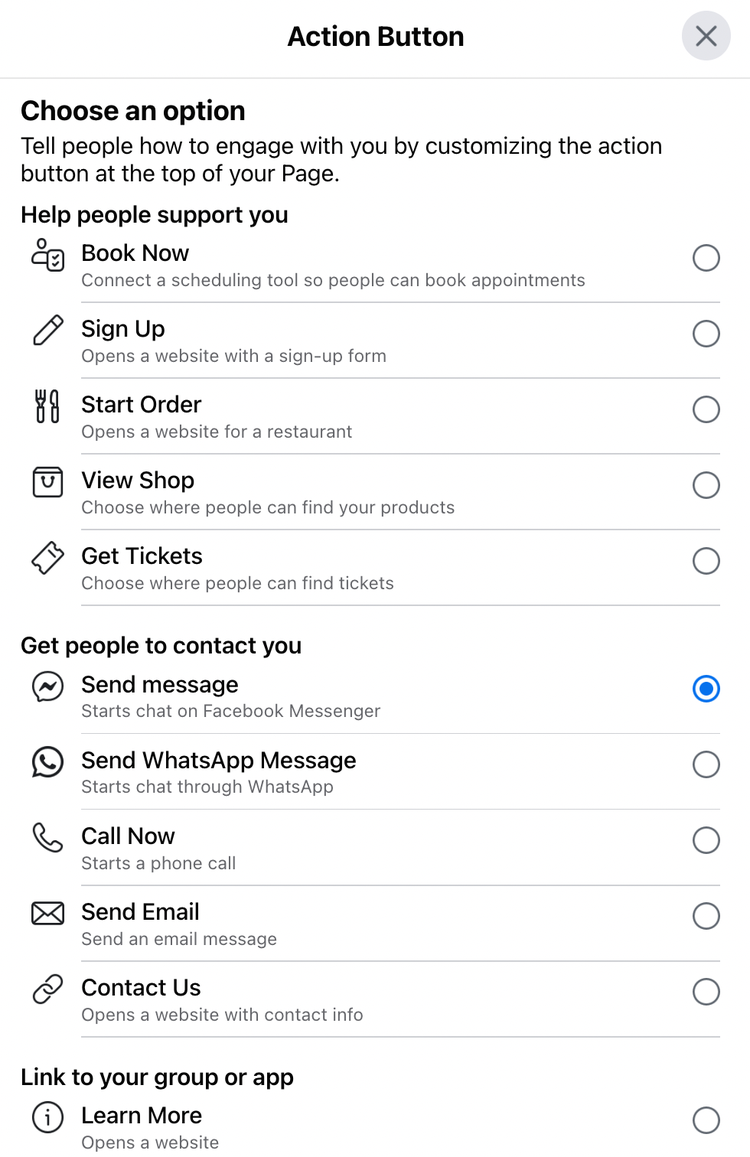
The About section of your Facebook business page is where you can give your visitors a chance to really get to know your company, along with your basic business details and page info. To edit this section, tap “About” below your cover photo next to “Posts” on your desktop page.
Here, you’ll be able to enter:
- Your contact information, including a phone number and website
- Your location and service area, which are especially important for local businesses
- Your business hours, including any temporary changes
- A longer description, which allows you to expand on your main description and tell a more detailed story about your brand, how it started, and what makes you different
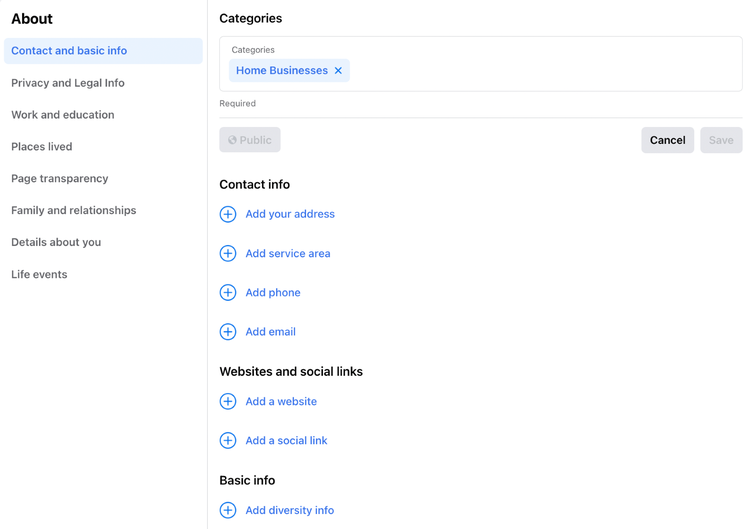
Once you complete your About section, look at your other page tabs to see if there’s any other business information you can enter. Depending on the type of page you have (which, again, was set based on your page categories), you may be able to make a list of your services or products, add offers, and more.
5. Start building your audience.
Your Facebook business page is pretty much ready for liftoff at this point. However, to make every post count, you need an active page audience to engage with each one.
To start building your audience, you can:
- Invite your Facebook friends to like the page.
- Cross-promote your page on your company’s other social media accounts.
- Link to your Facebook page on your website and in your marketing.
You can also directly chat with your most valued customers about your new page. This gives you a chance to ask them for Facebook Recommendations, which helps you build a positive reputation on the social media platform right off the bat.
6. Create your Facebook marketing strategy.
With your Facebook page set up and your audience beginning to grow, you can soon start posting on the platform. But before you begin ramping up your activity, we recommend putting together a Facebook marketing strategy first.
Your strategy can provide the guidance you need to send the right messages and stay on-brand. It can outline:
- Your goals: What are you hoping to achieve with your Facebook business page? Your Facebook marketing goals should align with your overall marketing and business goals in some way.
- Your target audience: Who are you speaking to, and what do you know about them? Your audience may be slightly different on Facebook than on other marketing channels, in part due to the unique demographics on the app and site.
- Your competition: What other Facebook pages target the same audiences or aim to sell similar products or services?
- Your resources: What is your Facebook marketing budget? How many posts per week can you commit to?
You can also nail down what type of content will work best for the Facebook users you’re targeting, what messages you want to send, and more to take your Facebook business page in the right direction as you start posting.
Optimize your business’ Facebook strategy.
Even when it may not seem like it, the biggest brands are doing more than blasting out daily posts on the fly. They’re using their brand identity and creativity to build standout content for their potential customers. You can do the same by using Adobe Express in a few different ways.
1. Facebook posts.
Make sure to post content on a consistent schedule to keep your audience engaged. Keeping your day-to-day posting consistent with your brand is the best way to get your content recognized as soon as it appears on news feeds. Of course, your content needs to be noticed first.
Create eye-catching Facebook posts either from scratch or from templates. Make sure to include your brand’s logo or website details. Think about your target audience — what type of content do they want to see? What will resonate the most with them?
2. Facebook Ads.
A brand-new Facebook page can take time to grow, but Facebook advertising is an affordable marketing channel that can help you get results in no time. To make every Facebook ad count, you’ll want to pair it with a photo, graphic, or video that captivates the Facebook users you’re targeting.
You can manage your Facebook ads through Facebook Business Manager, which will help guide your advertisement journey by providing you with information related to your specific business, such as which types of ads work best for your business and relevant keywords. Facebook ads (or Meta ads) are a great way to drive relevant traffic to your page and get momentum going.
3. Facebook Stories.
Facebook Stories are a great way to boost existing content or to post a short video. Sometimes Facebook posts get lost in people’s feeds, so posting a Facebook Story to support them is helpful. Facebook Stories appear at the top of everyone’s Facebook feeds, so they are a great way to draw attention to your brand and engage directly with your audience.
Facebook Stories only last 24 hours and can be viewed an unlimited number of times, so make sure to keep this in mind when creating your own.
4. Facebook Messenger.
Facebook Messenger provides an outlet for customers to interact directly with your business. Businesses can use Facebook Messenger in several ways — to provide customer service, answer questions, and even set up auto responses.
Authentic communication on Facebook Messenger is a great way to build loyalty and engage with new customers. Show customers that you care by integrating Messenger into your customer service strategy.
5. Pin a post.
Business Page owners are allowed to pin one post to the top of their page. A pinned post sits directly under your cover image, meaning it will be one of the first things your audience will see when they interact with your page. Use this opportunity to pin special announcements such as sales, limited-time deals, new products and services, and more.
To pin a post, simply click on the three dots at the top right corner of the post you want to pin and select “Pin post.”
6. Promote your Facebook Business Page.
Maximizing your Facebook presence is all about creating a special experience for your followers on the platform. This can mean:
- Hosting giveaways specifically for Facebook users
- Using free tools on the platform, like live video, to engage your audience
- Hosting special online events for your followers
- Sharing discounts on your “Offers” tab
- Creating a Facebook group for audience members to engage with your team and each other
How to use Facebook Insights.
Once you set up your Facebook Business Page, it’s time to start tracking your results. Luckily, Facebook does this for you by providing you with a ton of useful analytics. You can find the Insights page at the top of your Facebook Business Page.
Although the Insights dashboard will appear blank at first, as your page gains interactions, your dashboard will start populating with useful information, such as a demographics overview and your audience’s interests, hobbies, and lifestyles. Learning more about your audience will allow you to better tailor your content. Page Insights is a valuable tool that all Facebook Business Page users should utilize. Familiarize yourself with Insights and track metrics such as followers, reach, and visits.
Now you know how to make a Facebook Business Page that is optimized to drive engagement. You can reach potential new customers, engage with your audience, and even drive virality through your Facebook Business Page. Make sure not to overlook the potential that Facebook has to offer. Good luck on your Facebook Business Page journey!
This post was updated on June 20, 2023.



